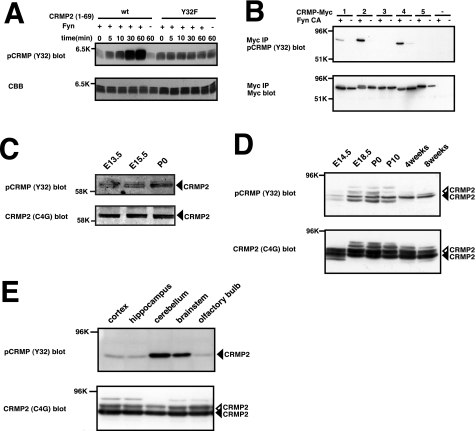FIGURE 5.
Tissue distribution of phosphorylated CRMP at Tyr32. A, specificity of phospho-specific antibody for CRMP2. The specificity of anti-pCRMP (Y32) antibody was examined with immunoblot analysis. Purified CRMP2wt-(1–69) or CRMP2Y32F-(1–69) was subjected to a phosphorylation assay using Fyn, separated by SDS-PAGE, and immunoblotted with anti-pCRMP (Y32) antibody. This antibody recognizes phosphorylated CRMP2 but not nonphosphorylated CRMP2. The phosphorylation levels of CRMP2 increase in a time-dependent manner. The same samples were separated by SDS-PAGE and stained with Coomassie Brilliant Blue (CBB) to show the amount of CRMP2 loaded. B, phosphorylation of CRMP1, CRMP2, and CRMP4 at Tyr32 by Fyn in HEK293T cells. HEK293T cells were transfected with CRMP1–5 alone or together with FynCA. The cell lysates were immunoprecipitated (IP) with anti-Myc antibody and then immunoblotted with anti-pCRMP (Y32) antibody and Myc antibody. This anti-pCRMP (Y32) antibody recognizes the phosphorylated form of CRMP2, CRMP4, and weakly CRMP1. C, developmental changes in the levels of the phosphorylated CRMP2 at Tyr32 in spinal cord. Spinal cord lysates (10 μg) at several developmental stages were immunoblotted with anti-pCRMP (Y32) antibody and anti-CRMP2 antibody (C4G). Black arrowheads indicate CRMP2. The multiple bands may be due to cross-reaction of the anti-pCRMP (Y32) antibody against the phosphorylated form of CRMP2 and CRMP4. D, developmental changes in the levels of the phosphorylated CRMP2 at Tyr32 in brain. Whole brain lysates (20 μg) at several developmental stages were immunoblotted with anti-pCRMP (Y32) antibody and anti-CRMP2 antibody (C4G). Black arrowheads indicate CRMP2. Open arrowheads indicate Ser/Thr-phosphorylated form of CRMP2. E, lysates (20 μg) of the cortex, hippocampus, cerebellum, brain stem, and olfactory bulb of adult mouse were immunoblotted with anti-pCRMP (Y32) antibody. The level of phosphorylated CRMP at Tyr32 was highest in the cerebellum. Black arrowheads indicate CRMP2. Open arrowhead indicates Ser/Thr-phosphorylated form of CRMP2.

